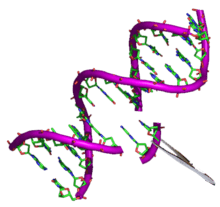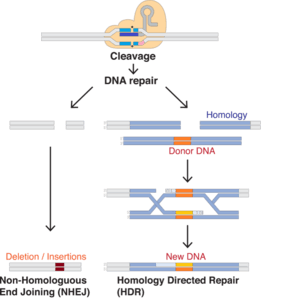Modifications (genetics)
Modifications are changes or differences between organisms' DNA in the same species that are due to differences in their environment. This is in contrast to mutations, which are changes in the genomes of organisms. Environmental differences that can affect an organism's characteristics (phenotype) include substrate, light, warmth, stress, exercise, and so on. Modifications are typically not heritable, however in some cases epigenetic modifications can be inherited. In both cases, there is no change to the primary DNA sequence (genotype), rather an influence on gene expression which is the cause of the altered phenotype.[2]

Modifiability
In ideal heredity, the genes of the parents are passed on to their offspring unchanged. That is why the organisms which carry the same genotype should be identical in every feature. However, this is not the case. Due to environmental conditions they can mutate, resulting in variation of organisms from each other up to a certain point. There are two types of modifications: the continuous modification and the switching modification.
To illustrate the modifiability you can take a look at our cultivated plants. The harvest of those plants do not only depend on the quality of the seeds but also greatly on environmental factors like the condition of the soil, the nutrient content of the soil, the fertilization, the humidity and temperature as well as the interference of other plants.
Genetic engineering is a type of intentional genetic modification, which uses biotechnology to alter an organism's genome.[3] This type of modification can involve insertions or deletions of DNA bases into the existing genetic code.[4]
Methods


Genetic modifications can occur naturally, through aforementioned mutations that can occur in an organism's genome, or through biotechnological methods of selecting a gene of interest to manipulate. In biotechnological methodology, the first step is to identify a trait of interest. The next step is to compare genomes of organisms in the same species, with and without the trait, to isolate the sequence of the specific trait of interest. The third step is to utilize the sequence and various enzymes to insert the trait's genes into a plasmid vector, which can then be inserted into bacteria to propagate the preferable gene. The following steps mainly consist of researchers testing the organism to ensure that the trait was transmitted successfully, and that no detriments are caused to the organism due to the new modification. [5] CRISPR methods are a specific variation of the aforementioned process of genome editing, which is the most accepted method, today.
Examples
.jpg)
In the example of the dandelion: most have long stems, but some have adapted to their environment by genetically modifying the stem length to be much shorter; to avoid being cut by lawnmowers. Because the shorter-stemmed dandelions had the genetic strength of living past the long-stemmed dandelions, the genetic frequency of a population can be altered, and thereby genetically modified.[6]
In a synthetic example in a laboratory, scientists isolated the gene that caused Alzheimer's in humans, the Amyloid precursor protein (APP) gene, and transmitted it into the nerve cells of worms. In doing this, scientists aimed to study the progression of Alzheimer's disease in worms by tagging the APP protein, so that scientists could visualize it as the worm aged; the ultimate goal was to apply their new understandings of the APP gene and its role in Alzheimer's disease to human research.[4][7]
Insulin[8] that humans inject for medical need is the first medical use of genetically modified bacteria, and an example of a product of synthetic genetic modification.[9] Through the following steps, scientists are able to genetically engineer a medical product that millions of people rely on worldwide:
- A small piece of DNA is extracted from a circular form of bacterial or yeast DNA called a plasmid. A scientist will extract this DNA through using specific restriction enzymes.
- Then, a scientist will insert the human gene for insulin into the gap left by the extracted DNA. This plasmid is now considered a genetically modified entity.
- Then, the genetically modified entity is reintroduced into a new bacterial or yeast cell.
- This cell will then undergo mitosis and divide rapidly, producing insulin suitable for human needs.
- Scientists grow the genetically modified bacteria or yeast in large fermentation vessels, which contain all of their necessary nutrients, and allow large amounts of insulin to be cultivated.
- When fermentation is complete, the mixture is filtered to produce the final the insulin.
- The insulin is then purified and packaged into bottles and insulin pens for distribution to patients with diabetes.[4]
Ethics
Ethical considerations regarding gene editing are largely controversial in society. The scientific community generally advocates on the side of caution when it comes to whether or not to utilize genome-edited organisms in everyday life. As aforementioned, genetic modifications are studied by researchers under controlled conditions after they are inserted into an organism, which allows for enhancement of the scientific understanding of the effects of certain gene modifications and certain organism responses, and can then be translated into more generalized research for further understanding. Scientists and policymakers are in agreement that public deliberations should decide the legality of germ line genome editing.[10]
The ethical issues of genetic modifications are highly debated, and there are many arguments that can be considered legitimate on both sides. A major argument over the accepted ethics for genetic modifications includes whether the genetic modifications are safe for humans and our environment to endure. While some individuals infer that if genetically modified organisms are tested under controlled laboratory conditions and ensured to be safe, then they will be safe for all purposes; other individuals feel that if genetically modified organisms are unnatural, then they will automatically cause detriment to our society, or they have uncertain potential for harm.[10]
References
- "Genetic engineering", Wikipedia, 2019-09-18, retrieved 2019-10-24
- Allison, Lizabeth A. (2012). Fundamental Molecular Biology. United States of America: John Wiley & Sons, Inc. pp. 354–355. ISBN 9781118059814.
- "Genetic engineering", Wikipedia, 2019-09-18, retrieved 2019-09-19
- "What is genetic engineering?". yourgenome. Retrieved 2019-09-19.
- "How to Make a GMO". Science in the News. 2015-08-09. Retrieved 2019-11-14.
- Entine, Jon. "GMOs, Yes!". Common Reader. Retrieved 2019-10-24.
- "Amyloid precursor protein", Wikipedia, 2019-09-22, retrieved 2019-10-24
- "Insulin", Wikipedia, 2019-10-10, retrieved 2019-10-24
- "Genetically modified bacteria", Wikipedia, 2019-10-05, retrieved 2019-10-24
- "What are the Ethical Concerns of Genome Editing?". Genome.gov. Retrieved 2019-11-14.